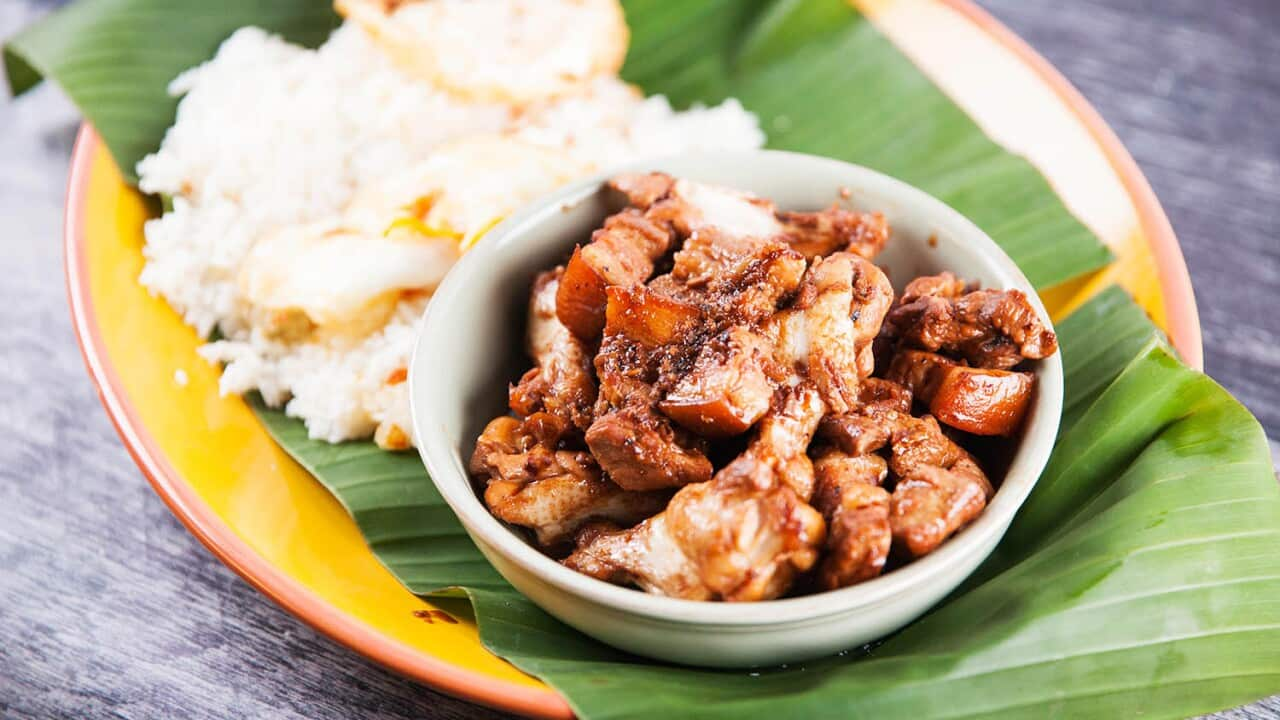--- Learn cooking techniques from across Asia with Diana Chan on the brand-new second season of Asia Unplated with Diana Chan, premieres Thursday 28 January on SBS Food, or stream it on SBS On Demand ---
Whether it’s flaked or braised, for any Filipino, a plate of tart, savoury adobo over rice is hard to pass up. Though chicken is one of the most popular, the dish is also commonly found made with pork, beef, eggplant, seafood, or a combination of proteins.
Here are five fun facts about adobo, and a recipe from the second season of Diana Chan’s brand-new series, Asia Unplated, which premieres Thursday 28 January on SBS Food and is streaming on SBS On Demand.
Chicken adobo

Filipino pork and chicken adobo
Vinegar is always added
The one thing that isn’t argued about when it comes to making adobo is that it’s made using a base of vinegar. Historically this was used to help keep food edible for longer as the vinegar acts as a preservative.
At its most basic, vinegar and soy are used to marinate meat which is then braised and the marinade reduced to create a flavourful sauce.
Prior to the Chinese introducing soy sauce to the Philippines, adobo was said to have been prepared using a vinegar and salt marinade, with soy replacing the salt component. Since it’s become a mainstay in the recipe for so long, soy is considered by most to be an acceptable staple.
Typically bay leaves, garlic and pepper join the flavour party too. The name translates in Spanish
The name translates in Spanish

Chipotle chillis in adobo sauce, a far cry from the Filipino staple.
‘Adobo’ in Spanish roughly translates to marinade or sauce. It’s hard to say exactly where the name of the dish came from, likely Spanish colonists, but it has other meanings around the world. In Spain, it refers to a specific process of marinating, in Mexico to a spicy, thick red sauce and in the Caribbean a seasoning or spice rub.
There are no limits
You can ‘adobo’ just about anything. From protein to vegetables, mushrooms or faux meat. The process is about the same for all of them, just marinate, braise, reduce and serve. Chicken and pork are often mixed to make a popular version of the dish.
The sauce is a delicate balance of sour and savoury, so make sure to follow the recipe and get the amount of vinegar and reduction just right - balance is key. Adobo flakes are a thing
Adobo flakes are a thing

Chicken adobo: just one of many classic Filipino dishes worthy trying. Source: Benito Martin
A crispy, dry version of this dish exists. It’s basically day-old pulled adobo that’s been fried until crispy and topped with extra fried garlic. You can find a recipe for it on the SBS Pinoy website here, or follow Diana Chan’s and flake then fry your leftovers.
There are heaps of variations
Like any popular dish, it looks different not just from city to city, but household to household. Some purists will marinate only in salt and vinegar, others in soy; some like it saucy, some dry. There’s even a version with coconut milk added called adobo manok sa gata.

A coconut milk variation on chicken adobo is also a popular staple. Source: Hradie Grant
Share
SBS Food is a 24/7 foodie channel for all Australians, with a focus on simple, authentic and everyday food inspiration from cultures everywhere. NSW stream only. Read more about SBS Food
Have a story or comment? Contact Us




